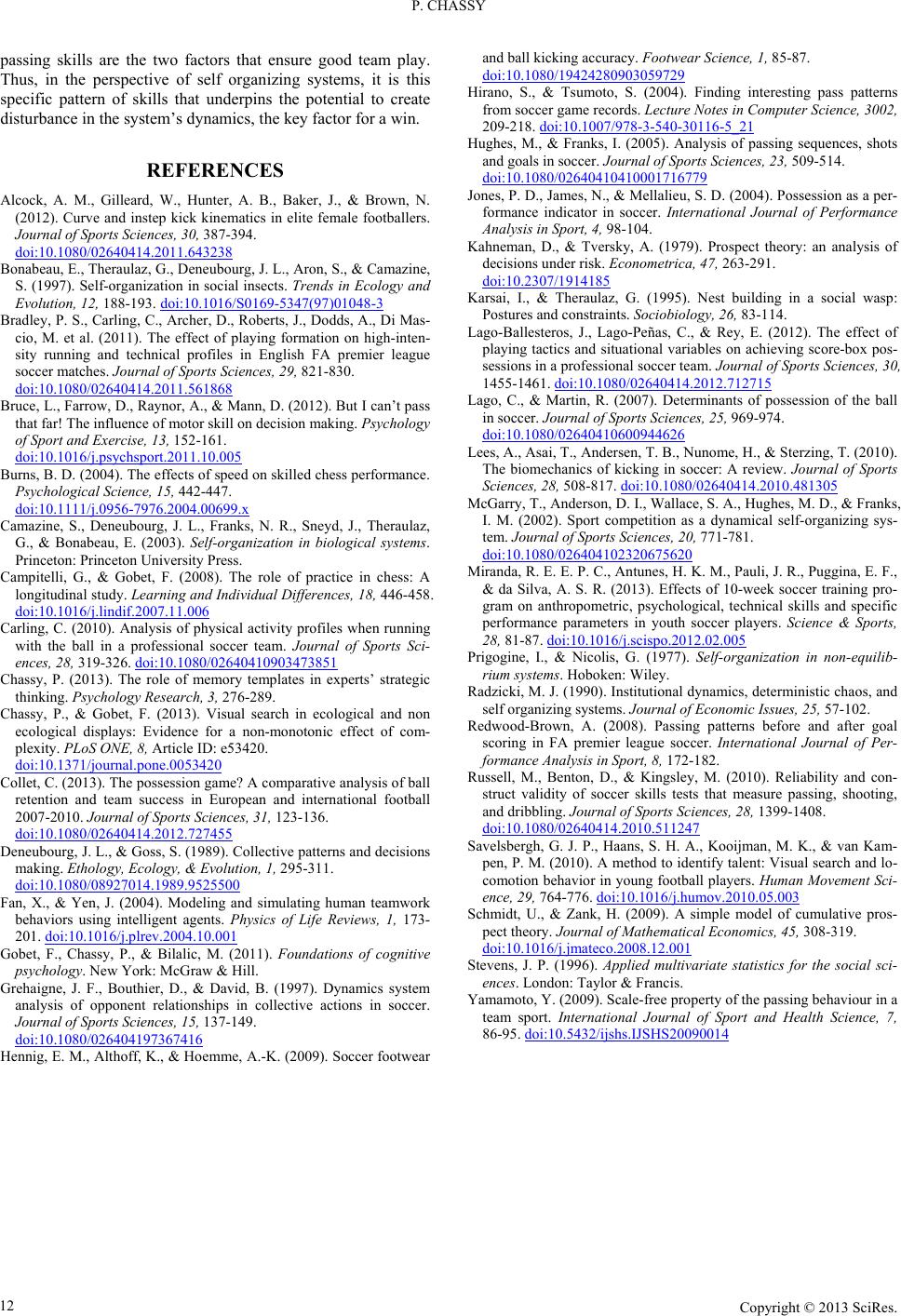
P. CHASSY
Copyright © 2013 SciRes.
12
passing skills are the two factors that ensure good team play.
Thus, in the perspective of self organizing systems, it is this
specific pattern of skills that underpins the potential to create
disturbance in the system’s dynamics, the key factor for a win.
REFERENCES
Alcock, A. M., Gilleard, W., Hunter, A. B., Baker, J., & Brown, N.
(2012). Curve and instep kick kinematics in elite female footballers.
Journal of Sports Sciences, 30, 387-394.
doi:10.1080/02640414.2011.643238
Bonabeau, E., Theraulaz, G., Deneubourg, J. L., Aron, S., & Camazine,
S. (1997). Self-organization in social insects. Trends in Ecology and
Evolution, 12, 188-193. doi:10.1016/S0169-5347(97)01048-3
Bradley, P. S., Carling, C., Archer, D., Roberts, J., Dodds, A., Di Mas-
cio, M. et al. (2011). The effect of playing formation on high-inten-
sity running and technical profiles in English FA premier league
soccer matches. Journal of Sports Sciences, 29, 821-830.
doi:10.1080/02640414.2011.561868
Bruce, L., Farrow, D., Raynor, A., & Mann, D. (2012). But I can’t pass
that far! The influence of motor skill on decision making. Psychology
of Sport and Exercise, 13, 152-161.
doi:10.1016/j.psychsport.2011.10.005
Burns, B. D. (2004). The effects of speed on skilled chess performance.
Psychological Science, 15, 442-447.
doi:10.1111/j.0956-7976.2004.00699.x
Camazine, S., Deneubourg, J. L., Franks, N. R., Sneyd, J., Theraulaz,
G., & Bonabeau, E. (2003). Self-organization in biological systems.
Princeton: Princeton University Press.
Campitelli, G., & Gobet, F. (2008). The role of practice in chess: A
longitudinal study. Learning and Individual Differences, 18, 446-458.
doi:10.1016/j.lindif.2007.11.006
Carling, C. (2010). Analysis of physical activity profiles when running
with the ball in a professional soccer team. Journal of Sports Sci-
ences, 28, 319-326. doi:10.1080/02640410903473851
Chassy, P. (2013). The role of memory templates in experts’ strategic
thinking. Psychology Research, 3, 276-289.
Chassy, P., & Gobet, F. (2013). Visual search in ecological and non
ecological displays: Evidence for a non-monotonic effect of com-
plexity. PLoS ONE, 8, Article ID: e53420.
doi:10.1371/journal.pone.0053420
Collet, C. (2013). The possession game? A comparative analysis of ball
retention and team success in European and international football
2007-2010. Journal of Sports Sciences, 31, 123-136.
doi:10.1080/02640414.2012.727455
Deneubourg, J. L., & Goss, S. (1989). Collective patterns and decisions
making. Ethology, Ecology, & Evolution, 1, 295-311.
doi:10.1080/08927014.1989.9525500
Fan, X., & Yen, J. (2004). Modeling and simulating human teamwork
behaviors using intelligent agents. Physics of Life Reviews, 1, 173-
201. doi:10.1016/j.plrev.2004.10.001
Gobet, F., Chassy, P., & Bilalic, M. (2011). Foundations of cognitive
psychology. New York: McGraw & Hill.
Grehaigne, J. F., Bouthier, D., & David, B. (1997). Dynamics system
analysis of opponent relationships in collective actions in soccer.
Journal of Sports Sciences, 15, 137-149.
doi:10.1080/026404197367416
Hennig, E. M., Althoff, K., & Hoemme, A.-K. (2009). Soccer footwear
and ball kicking accuracy. Footwear Science, 1, 85-87.
doi:10.1080/19424280903059729
Hirano, S., & Tsumoto, S. (2004). Finding interesting pass patterns
from soccer game records. Lecture Notes in Computer Science, 3002,
209-218. doi:10.1007/978-3-540-30116-5_21
Hughes, M., & Franks, I. (2005). Analysis of passing sequences, shots
and goals in soccer. Journal of Sports Sciences, 23, 509-514.
doi:10.1080/02640410410001716779
Jones, P. D., James, N., & Mellalieu, S. D. (2004). Possession as a per-
formance indicator in soccer. International Journal of Performance
Analysis in Sport, 4, 98-104.
Kahneman, D., & Tversky, A. (1979). Prospect theory: an analysis of
decisions under risk. Econometrica, 47, 263-291.
doi:10.2307/1914185
Karsai, I., & Theraulaz, G. (1995). Nest building in a social wasp:
Postures and constraints. Sociobiology, 26, 83-114.
Lago-Ballesteros, J., Lago-Peñas, C., & Rey, E. (2012). The effect of
playing tactics and situational variables on achieving score-box pos-
sessions in a professional soccer team. Journal of Sports Sciences, 30,
1455-1461. doi:10.1080/02640414.2012.712715
Lago, C., & Martin, R. (2007). Determinants of possession of the ball
in soccer. Journal of Sports Sciences, 25, 969-974.
doi:10.1080/02640410600944626
Lees, A., Asai, T., Andersen, T. B., Nunome, H., & Sterzing, T. (2010).
The biomechanics of kicking in soccer: A review. Journal of Sports
Sciences, 28, 508-817. doi:10.1080/02640414.2010.481305
McGarry, T., Anderson, D. I., Wallace, S. A., Hughes, M. D., & Franks,
I. M. (2002). Sport competition as a dynamical self-organizing sys-
tem. Journal of Sports Sciences, 20, 771-781.
doi:10.1080/026404102320675620
Miranda, R. E. E. P. C., Antunes, H. K. M., Pauli, J. R., Puggina, E. F.,
& da Silva, A. S. R. (2013). Effects of 10-week soccer training pro-
gram on anthropometric, psychological, technical skills and specific
performance parameters in youth soccer players. Science & Sports,
28, 81-87. doi:10.1016/j.scispo.2012.02.005
Prigogine, I., & Nicolis, G. (1977). Self-organization in non-equilib-
rium systems. Hoboken: Wiley.
Radzicki, M. J. (1990). Institutional dynamics, deterministic chaos, and
self organizing systems. Journal of Economic Issues, 25, 57-102.
Redwood-Brown, A. (2008). Passing patterns before and after goal
scoring in FA premier league soccer. International Journal of Per-
formance Analysis in Sport, 8, 172-182.
Russell, M., Benton, D., & Kingsley, M. (2010). Reliability and con-
struct validity of soccer skills tests that measure passing, shooting,
and dribbling. Journal of Sports Sciences, 28, 1399-1408.
doi:10.1080/02640414.2010.511247
Savelsbergh, G. J. P., Haans, S. H. A., Kooijman, M. K., & van Kam-
pen, P. M. (2010). A method to identify talent: Visual search and lo-
comotion behavior in young football players. Human Movement Sci-
ence, 29, 764-776. doi:10.1016/j.humov.2010.05.003
Schmidt, U., & Zank, H. (2009). A simple model of cumulative pros-
pect theory. Journal of Mathematical Economics, 45, 308-319.
doi:10.1016/j.jmateco.2008.12.001
Stevens, J. P. (1996). Applied multivariate statistics for the social sci-
ences. London: Taylor & Francis.
Yamamoto, Y. (2009). Scale-free property of the passing behaviour in a
team sport. International Journal of Sport and Health Science, 7,
86-95. doi:10.5432/ijshs.IJSHS20090014